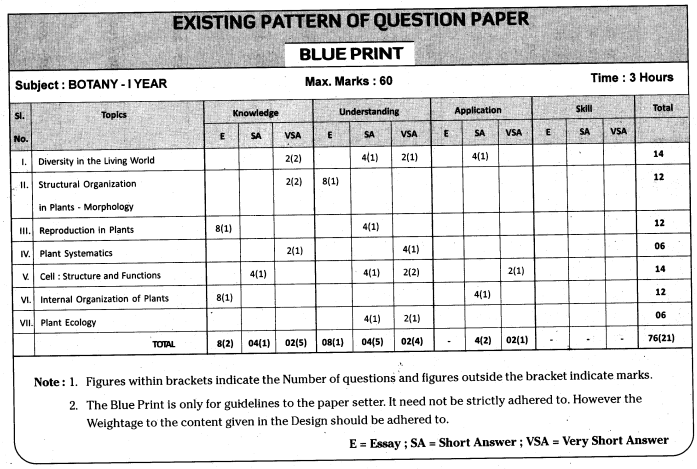Here you will find Telangana TSBIE State Board Syllabus TS Inter 1st Year Botany Study Material Pdf free download, TS Intermediate 1st Year Botany Textbook Solutions Questions and Answers in English Medium and Telugu Medium according to the latest exam curriculum. The chapter-wise TS Inter 1st Year Study Material will help the students in understanding the concept behind each question in a detailed way.
Students can check the TS Inter 1st Year Botany Syllabus & TS Inter 1st Year Botany Important Questions for strong academic preparation. Students can use TS Inter 1st Year Botany Notes as a quick revision before the exam.
TS Intermediate 1st Year Botany Study Material Pdf Download | TS Inter 1st Year Botany Textbook Solutions Telangana
Unit I Diversity in the Living World
- Chapter 1 The Living World
- Chapter 2 Biological Classification
- Chapter 3 Science of Plants – Botany
- Chapter 4 Plant Kingdom
Unit II Structural Organisation in Plants – Morphology
Unit III Reproduction in Plants
Unit IV Plant Systematics
Unit V Cell Structure and Function
Unit VI Internal Organisation of Plants
Unit VII Plant Ecology
TS Inter 2nd Year Botany Weightage Blue Print 2022-2023

TS Inter 1st Year Botany Syllabus
Telangana TS Intermediate 1st Year Botany Syllabus
TELANGANA STATE BOARD OF INTERMEDIATE EDUCATION, HYDERABAD
BOTANY – I
SYLLABUS (w.e.f. 2012-13)
Unit-I DIVERSITY IN THE LIVING WORLD (30 Periods)
CHAPTER-1 The living world
What is living? – Diversity in the living world; Taxonomic categories and Taxonomic aids
CHAPTER-2 Biological Classification
Five kingdom classification – Monera, Protista, Monera, Protista, Fungi, Plantae and Animalia, Three domains of life (six kingdom classification), Viruses, Viroids, Prions & Lichens
CHAPTER-3 Science of plants – Botany
Origin, Development, and Branches of Botany, Scope of Botany and Branches of Botany
CHAPTER-4 Plant Kingdom
Salient features, classification and alteration of generations of the plants of the following groups – Algae, Bryophytes, Pteridophytes, Gymnosperms and Angiosperms
UNIT – II STRUCTURAL ORGANISATION IN PLANTS-MORPHOLOGY (20 Periods)
CHAPTER-5 Morphology of flowering plants
Vegetative: Parts of a typical Angiospermic plant; Vegetative morphology and modifications- Root, Stem and Leaf- types; Venation, Phyllotaxy.
Reproductive: Inflorescence – Racemose, Cymose and special types (in brief). Flower: Parts of a flower and their detailed description; Aestivation, Placentation. Fruits: Types- True, False and parthenocarpic fruits.
UNIT-III: REPRODUCTION IN PLANTS (25 Periods)
CHAPTER-6 Modes of Reproduction
Asexual reproduction, binary fission, Sporulation, budding, fragmentation, vegetative propagation in plants, Sexual reproduction in brief, Overview of angiosperm life cycle.
CHAPTER-7 SEXUAL REPRODUCTION IN FLOWERING PLANTS
Stamen, microsporangium, pollen grain. Pistil, megasporangium (ovule) and embryo sac; Development of male and female gametophytes. Pollination – Types, agents, Out breeding devices and Pollen – Pistil interaction. Double Fertilization; Post fertilisation events: Development of endosperm and embryo; development of seed, Structure of Dicotyledonous and Monocotyledonous seeds, Significance of fruit and seed. Special modes – Apomixis, parthenocarpy, polyembryony.
UNIT-IV: PLANT SYSTEMATICS (10 Periods)
CHAPTER-8 Taxonomy of angiosperms
Introduction. Types of Systems of classification (In brief). Semi-Technical description of a typical flowering plant Description of Families: Fabaceae, Solanaceae and Liliaceae.
UNIT-V: CELL STRUCTURE AND FUNCTIONS (35 Periods)
CHAPTER-9 CELL: THE UNIT OF LIFE
Cell- Cell theory and cell as the basic unit of life- overview of the cell. Prokaryotic cells, Ultra Structure of Plant cell (structure in detail and functions in brief), Cell membrane, Cell wall, Cell organelles: Endoplasmic reticulum, Mitochondria, Plastids, Ribosomes, Golgi bodies, Vacuoles, Lysosomes, Microbodies, Centrosome and Centriole, Cilia, Flagella, Cytoskeleton and Nucleus. Chromosomes: Number, structural organization; Nucleosome.
CHAPTER-10 Biomolecules
Structure and function of Proteins, Carbohydrates, Lipids and Nucleic acids.
CHAPTER-11 Cell cycle and cell division
Cell cycle, Mitosis, Meiosis – significance.
UNIT-VI: INTERNAL ORGANISATION OF PLANTS (25 Periods)
CHAPTER-12 HISTOLOGY AND ANATOMY OF FLOWERING PLANTS
Tissues – Types, structure and functions: Meristematic; Permanent tissues – Simple and Complex tissues. Tissue systems – Types, structure and function: Epidermal, Ground and Vascular tissue systems. Anatomy of Dicotyledonous and Monocotyledonous plants – Root, Stem and Leaf. Secondary growth in Dicot stem and Dicot root.
UNIT-VII: PLANT ECOLOGY (12 Periods)
CHAPTER-13 ECOLOGICAL ADAPTATION, SUCCESSION AND ECOLOGICAL SERVICES
Introduction. Plant communities and Ecological adaptations: Hydrophytes, Mesophytes and Xerophytes. Plant succession. Ecological services – Carbon fixation, Oxygen release and pollination (in brief).
We hope this TS Intermediate 1st Year Botany Study Material Pdf Download in English Medium and Telugu Medium will be useful for students to attain the right approach for precisely answering the textbook questions. If there is any trouble in grasping the concepts related to TS Inter 1st Year Botany Textbook Solutions Telangana, drop your questions in the comment and we will get back to you with a solution in time.